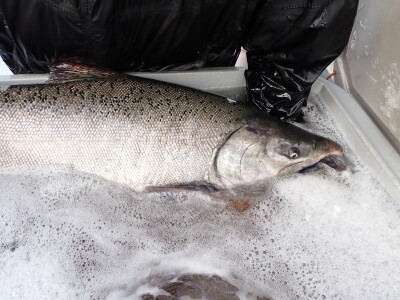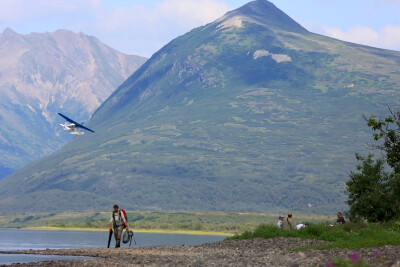Northeast
Downsizing lobster boat saves fuel; 66-foot longliner for Nova Scotia
What's a good indication a boatshop is building a boat that meets a fisherman's needs? Probably when the fisherman comes back for a second boat — and a third.
That's how many times Shawn Murray has pulled away from the dock at Dana's Boat Shop on Westport Island, Maine, with a new lobster boat. All have had dark-blue hulls and all carry the name Suspicion.
The first was a Libby 38. The next was an RP 40, and the current one is a Wayne Beal 36. At a time when many lobstermen have been going with larger boats, Murray, says Dana Faulkingham, the boatshop's owner, "is looking at the economics of fishing. He can do the same fishing with the 36 for about half the cost of fuel. He's looking at the economics and what lobster is worth today."
If Maine has a shrimp season this winter — and it is in question — Murray may also use the Suspicion for shrimp trapping.
Just because Murray's current Suspicion is a bit shorter than his other boats, doesn't mean he can't carry a lot of lobster traps. Faulkingham figures Murray can put 100 traps on deck if he has to. Though with a load like that, the Suspicion won't be hitting the 23 knots she made on sea trials, but with a 450-hp John Deere matched up with a Twin Disc marine gear with a 2.5:1 reduction it won't be too shabby.
The Suspicion is the first Wayne Beal hull that Faulkingham has finished off, but he came away impressed with the quality of the hull and top package that was trucked to his shop. "It goes together good. It's a nice unit," he says.
Up forward there's what you would expect, a V-berth and storage. Back aft and under a deck hatch, Faulkingham built a molded inspection well over the prop that allows line to be cleared from the prop and shaft. "You pop the internal out and you can reach right down to the prop and shaft," and clear the line, Faulkingham says. Though if you have short arms you'd need a knife on the end of a stick.
The inspection well is inside a watertight enclosure that shuts off the lazarette from the rest of boat to prevent downflooding.
Up in Meteghan River, Nova Scotia, A.F. Theriault & Son and ALS Fisheries in Sambro, Nova Scotia, have done one better than Dana's Boatshop and Shawn Murray. In August, A.F. Theriault delivered the fourth boat to ALS Fisheries. This one is the Emry & Boys, a fiberglass 66' x 28' x 7' 6" longliner. Though she's not the biggest — that was the 100-foot steel longliner Ivy Rose in 2000.
The fiberglass hull that A.F. Theriault finished off is a Grizzly that has a Cape Island look with its broken sheer line and raised foredeck. It was built by Aylward Fiberglass in Barrington, Nova Scotia.
The hull is different "from most Cape Island-style boats that are molded now," says Dana Stewart at Aylward Fiberglass. "It's a computer-generated mold that's probably eight years old. Most molds around here are probably 20 years old or better."
He adds that it's "more in proportion" for a boat the size of Emry & Boys since the hull is based on a previous 50-foot hull — the Monster hull — as opposed to scaling up from a 38- or 40-foot hull. "This one is probably deeper forward than most," he notes. "It's used for scallop draggers, longliners and fish draggers."
The hull is solid fiberglass with foam stiffeners. "There's not a stick of wood in the boat except for the trim," says A.F. Theriault's Gilles Theriault. The decks, bulkheads and wheelhouse are all cored with Diab H60 PVC foam. The deck is 3 inches thick with fiberglass on both sides.
There's a refrigerated fish hold and bait freezer. Up forward is the engine room with a single 485-hp Caterpillar C18 that's matched up to a Twin Disc gear with a 6:1 reduction that turns a five-blade 60" x 52" prop.
Theriault says the boat makes between 9 and 10 knots.
Power for the refrigeration comes from a pair of 21-kW Caterpillar C2.2 generators. There are accommodations for six, including a dedicated captain's cabin. — Michael Crowley
West
Maine boat gets a West Coast rebuild; California yard has its sponsoning niche
A lot of hours and miles have passed under the keel of John Wilson's boat, the Sea Fever. For 20 years he's fished rock crab and spiny lobster out of Santa Barbara, Calif. Prior to that there was the 3,000-and-some mile overland trip across the country to the West Coast. Before that, some years fishing lobsters out of Corea, Maine.
Rodney Sullivan, a Corea lobsterman, had owned the 44' x 16' Young Brothers-built lobster boat for a "few years," says Wilson. Then one day, with 1,200 wooden traps aboard, the boat sank at Sullivan's dock in Corea. He had her hauled out, "redid the entire boat and then used it for a season and called it quits," Wilson says. That was 1993, and Wilson came east and bought the boat.
Recently, the Sea Fever was rebuilt again, to the tune of $95,000. A big problem was the deck. Like a lot of lobster boats built in New England, the underside of the plywood deck wasn't sealed, and that's where the rot got at it.
The entire hydraulic system and all the electrical wiring was removed. The rudder was straightened, and the Sea Fever has a new 435-hp Caterpillar 3208. The accommodations area for four — the Sea Fever makes three-day trips. — was ripped out and completely rebuilt.
It's easy to see why Wilson says, "basically I rebuilt the entire boat." Well, Wilson along with the crew at Ventura Harbor Boatyard in Ventura, which is just south of Santa Barbara. Wilson doesn't hold back in his praise of the yard: "It's the most fabulous commercial fishing yard you can find in Southern California."
The new deck is marine plywood, fiberglassed on both sides with a pair of aluminum beams running fore and aft under the deck for support. The boatyard fabricated a 4-foot aluminum extension that's attached to the transom.
Wilson says he looked into buying a new boat, "but getting a boat that size and what I wanted out of it out here again, would cost more than double what I spent. I know the boat inside and out, and it's been a good boat for me." With the work completed, Wilson says, "It's like brand new, like it just came out of the showroom."
Up the coast in Crescent City, Calif., Fashion Blacksmith continues to do what it does best, and that's making fishing boats wider and sometimes longer. The boatyard recently finished sponsoning the Courageous, and the Heidi Sue will be finished in a month. After that, there are six to eight more boats to sponson and a 58-foot seiner to build for an owner in Alaska.
The Dungeness crabber Courageous came to Fashion Blacksmith measuring 54' x 15' and left at 58 feet long and 24 feet wide. John and Kacie Hankins in Warrenton, Ore., own the boat.
Mike Pettis of Newport, Ore., owns the crabber Heidi Sue, which Fashion Blacksmith built for another owner in 1973. The length of the 60-foot crabber hasn't changed, but she's been widened from 18 to 26 feet. Boats like these get widened and lengthened for "safety, stability and the economics that come with a larger vessel," says Fashion Blacksmith's Ted Long.
For these boats, part of the work at Fashion Blacksmith includes lowering the transom and adding a bulbous bow. "We feel the transom can be lowered quite a bit and not create drag and affect the fuel performance, and gain a lot of buoyancy," says Long. "Then we put a bow bulb on.
"Between these two things — lowering the transom and adding the bow bulb," he says boats coming out of Fashion Blacksmith have gained speed in a light condition and are "maybe only a tad slower when fully tanked."
The gain in speed is between three-quarters of a knot to 1.5, while generally reducing the engine speed by 100 rpm. "That gives better fuel efficiency, and there's less strain on the engine," Long points out. — Michael Crowley
South
Chicken barns make great boatshops; barcat will be oystering in deep water
Maryland boatbuilder Joey Miller of Sinepuxent Boatworks in Berlin, Md., expanded his boatshop by moving into a 350' x 36' chicken grow-out house. He had been building boats in a 55' x 36' chicken house, but an increase in boat orders prompted him to move. He is using 80 feet of the building. "Now I've got some room to expand if I need to," says Miller.
Miller likes using a chicken house for building boats, because "they have dirt floors that don't hurt your feet when you have to stand on it all day long, like a concrete floor does," he says.
Old chicken houses are prevalent on Maryland's Eastern Shore, as the chicken business is a large part of the area's economy. Miller is putting his to good use. A waterman turned boatbuilder, he has a 27' x 9' open deadrise boat just about completed for a trotline crabber in Centreville, Md. A 130-hp Evinrude outboard will power the crabber, which is built of fiberglass over wood.
The cypress frames are 1 1/2" x 3 1/2" and covered with 3/8-inch plywood on the sides. The bottom is made up of two layers of quarter-inch laminated marine plywood. The entire boat is covered with 1708 biaxial fiberglass cloth and epoxy resin.
Miller recently delivered a 20' x 8' 6" skiff to an eel potter in Chesapeake City, Md. Its cockpit has scuppers built into the stern, making it self-draining. The sides are 3/8-inch plywood and the bottom 3/4-inch plywood covered with 1708 biaxial fiberglass.
A 23-foot deadrise skiff is going to an Ocean City, Md., crab potter and a 17-footer will be a yacht tender. Cold-molded construction is being used for the tender. When it's done, Miller says it will be "like a boat you see on the Florida Keys with a man standing on the bow and poling the boat along."
"There is still demand for small commercial fishing boats on Chesapeake Bay, and I'm finding that out," Miller says.
Virginia's watermen spent a fair amount of time getting their boats ready for the public oyster season, which opened in October. One outfit, Shores & Ruark Seafood Co. in Urbanna, recently purchased a second barcat from a Tangier Island crabber, then had the 28' x 10' boat repaired and converted to oyster dredging.
Barcats are low-sided, deadrise and cross-planked wooden boats usually used in the island waters of Virginia's Eastern Shore for crab scraping. On Smith Island, Md., the boats are called scrape boats, while on Tangier Island they are known as barcats.
Charles Brooks of Mathews County, Va., did the repair work. That included fixing a rotten shaft log and replacing several bottom planks. To accommodate the oyster dredging, he installed a mast and boom and raised the collar (in other places referred to as a coaming) on the inside of the washboards by 10 inches.
"Barcats are very low to the water," says Rufus Ruark, vice president of Shores & Ruark. "We raised the collars up to knock down seas breaking over the boat. The high collars make it better for oystering. Barcats are built primarily to be used in shallow protected waters but we oyster in deep water and can run into some rough seas."
A 4-53 Detroit Diesel powers Shores & Ruark's barcat. "Boy they are tough motors," says Ruark. "What did Henry Lackey say? 'They won World War II for us.'" (Lackey is a well-known diesel mechanic in the Tidewater, Va., region.)
Rufus Ruark Jr. is president of the firm and named the barcats after his sons. The company's new barcat is the Capt. Jack, and the older boat the Capt. Cole. The firm's oyster barge is named Miss Delaney after his daughter.
"What is the old saying? Never name a boat after your wife. Name them after your children, because your children will always be your children, but your wife might not always be your wife." Ruark Sr. joked. — Larry Chowning






